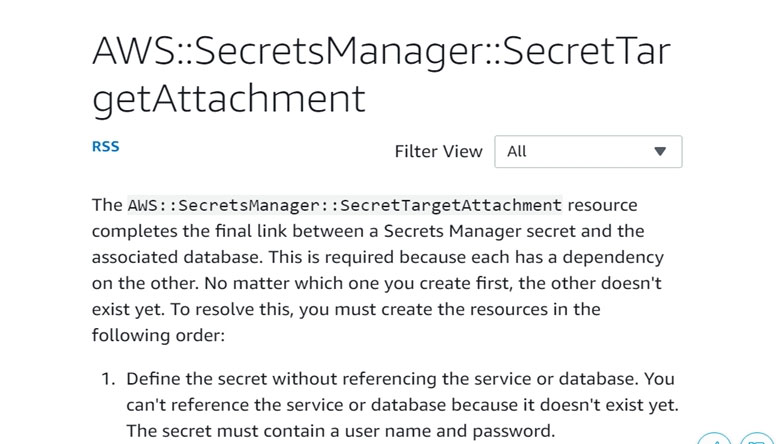A company wants to automate the creation of secure test databases with random credentials to be stored safely for later use. The credentials should have sufficient information about each test database to initiate a connection and perform automated credential rotations. The credentials should not be logged or stored anywhere in an unencrypted form.
Which steps should a Database Specialist take to meet these requirements using an AWS CloudFormation template?
C
Reference:
https://docs.aws.amazon.com/AWSCloudFormation/latest/UserGuide/aws-resource-secretsmanager-secrettargetattachment.html
A company is going to use an Amazon Aurora PostgreSQL DB cluster for an application backend. The DB cluster contains some tables with sensitive data. A
Database Specialist needs to control the access privileges at the table level.
How can the Database Specialist meet these requirements?
C
Reference:
https://aws.amazon.com/blogs/database/managing-postgresql-users-and-roles/
A Database Specialist is working with a company to launch a new website built on Amazon Aurora with several Aurora Replicas. This new website will replace an on-premises website connected to a legacy relational database. Due to stability issues in the legacy database, the company would like to test the resiliency of
Aurora.
Which action can the Database Specialist take to test the resiliency of the Aurora DB cluster?
B
Reference:
https://docs.aws.amazon.com/AmazonRDS/latest/AuroraUserGuide/AuroraMySQL.Managing.FaultInjectionQueries.html
A company just migrated to Amazon Aurora PostgreSQL from an on-premises Oracle database. After the migration, the company discovered there is a period of time every day around 3:00 PM where the response time of the application is noticeably slower. The company has narrowed down the cause of this issue to the database and not the application.
Which set of steps should the Database Specialist take to most efficiently find the problematic PostgreSQL query?
D
A company has a web-based survey application that uses Amazon DynamoDB. During peak usage, when survey responses are being collected, a Database
Specialist sees the ProvisionedThroughputExceededException error.
What can the Database Specialist do to resolve this error? (Choose two.)
CE
Reference:
https://forums.aws.amazon.com/thread.jspa?threadID=174315
A company is running a two-tier ecommerce application in one AWS account. The web server is deployed using an Amazon RDS for MySQL Multi-AZ DB instance. A Developer mistakenly deleted the database in the production environment. The database has been restored, but this resulted in hours of downtime and lost revenue.
Which combination of changes in existing IAM policies should a Database Specialist make to prevent an error like this from happening in the future? (Choose three.)
ACD
A company is building a new web platform where user requests trigger an AWS Lambda function that performs an insert into an Amazon Aurora MySQL DB cluster. Initial tests with less than 10 users on the new platform yielded successful execution and fast response times. However, upon more extensive tests with the actual target of 3,000 concurrent users, Lambda functions are unable to connect to the DB cluster and receive too many connections errors.
Which of the following will resolve this issue?
B
A company is developing a multi-tier web application hosted on AWS using Amazon Aurora as the database. The application needs to be deployed to production and other non-production environments. A Database Specialist needs to specify different MasterUsername and MasterUserPassword properties in the AWS
CloudFormation templates used for automated deployment. The CloudFormation templates are version controlled in the company's code repository. The company also needs to meet compliance requirement by routinely rotating its database master password for production.
What is most secure solution to store the master password?
C
A company is writing a new survey application to be used with a weekly televised game show. The application will be available for 2 hours each week. The company expects to receive over 500,000 entries every week, with each survey asking 2-3 multiple choice questions of each user. A Database Specialist needs to select a platform that is highly scalable for a large number of concurrent writes to handle the anticipated volume.
Which AWS services should the Database Specialist consider? (Choose two.)
AE
A company has migrated a single MySQL database to Amazon Aurora. The production data is hosted in a DB cluster in VPC_PROD, and 12 testing environments are hosted in VPC_TEST using the same AWS account. Testing results in minimal changes to the test data. The Development team wants each environment refreshed nightly so each test database contains fresh production data every day.
Which migration approach will be the fastest and most cost-effective to implement?
A